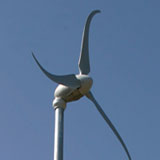|
Event Horizon Solar & Wind LLC Providing Solar and Wind power for 12 years. (616) 389-3172 9am to 5pm eastern. |
Basics
of Wind Power
Wind power in Michigan and the mid-west is the fastest growing energy source in
the region
|
Event Horizon Solar & Wind LLC Providing Solar and Wind power for 12 years. (616) 389-3172 9am to 5pm eastern. |
Basics
of Wind Power
Wind power in Michigan and the mid-west is the fastest growing energy source in
the region
|
We supply everything you need, including tower kits and accessories. We provide free design and technical support for our customers. |
|
 Quick-scroll down to wind generator
and turbine comparison Quick-scroll down to wind generator
and turbine comparison
When planning a wind generator installation, you need to determine your site's potential power output. To help you, we provide extensive data on wind resources for your area, and we can inspect your particular site if needed. Often, a simple sketch of your site showing features such as tree stands and structures, combined with our wind data and extensive experience, is sufficient for planning. For larger applications we will conduct a site inspection. Call us for more information on all of our services. If you are considering a PV-wind hybrid system, you will want to balance the size of the array with the power rating of the turbine. We can help determine the most effective combination of power sources. Hybrid systems are well suited for Michigan and the mid-west, due to our variable weather pattern. Some turbines can be erected on top of, or attached to a building. Unless there are
adequate vibration isolators, there will be some structural vibration. We do not recommend this practice with larger generators, on smaller homes,
older homes or buildings with lightweight frames. A separate tower should be used for these installations, which may still be close to the building
if desired.
In addition to adequate wind speed, your site must have enough clearance for the turbine and tower. It's generally recommended that the unit be 20 feet higher than any structure or other item within 100 feet. Enough space must be available to lay the tower on the ground. Because of voltage line drop, the distance from the tower to the point of use is also a factor to be considered. It is also very important to install proper electrical grounding for the tower and unit. Typically, towers range in height from 30-85 feet. Voltages available in wind generators vary from unit to unit, and some
are adjustable. Both low and high voltage models are available, from 12 volts to 240 volts. We can supply you with small, medium
and large generators.
Wind generators' output varies with wind speed. They usually begin to spin between 6 - 8 MPH, usable charging amps begins around 10 MPH, with the maximum rated output usually occurs in wind speeds of 25 - 30 MPH. On a given day, wind speeds and the resulting charging amps, varies greatly, so we must use an average of wind speeds over a day, month or year. Keep in mind that wind speed at the top of a tower is higher than along the ground. A wind generator usually has a built-in governing feature which causes the generator to slow itself down when wind speeds exceed a certain point. This is needed to prevent potential damage to the blades and alternator. Most generators we sell have built-in governing features. Some units do not require governing by design. Some wind units like the AIR 403 have built-in battery charge regulation circuitry to prevent overcharging your battery and eliminating the need for an external charge regulator. A wind generator should also have a "break" to stop the unit. Smaller units usually have a control box and switch that 'grounds' the unit, creating sufficient drag to stop the turbine. Much larger units may have a mechanical brake. Some applications, such as water pumps, can run directly from a wind generator, eliminating the need for storage batteries, inverters and other components. However, in these applications, the turbine and pump must be specifically matched to function properly. Grid-tie is also viable using an inverter to process the charge amps creating a "sell" feature, however higher average wind speeds are required to make this option cost effective. However, when the unit's charge amps are used to power normal 120/240v appliances, equipment, etc. a battery bank and inverter is used. The batteries supply the total required DC amps to the inverter for AC loads when demanded, and the generator re-charges the batteries. In grid-tied or utility interactive systems either all or part of the power may be sold to the utility company or used to reduce total utility consumption. Systems which only sell power do not require batteries when configured with a specific "grid-tie" inverter. Below is a simple visual observation table to give you a general idea of winds speeds based on observable conditions. Naturally, this information isn't considered scientifically reliable, but may encourage you to consider your site for wind power. |
| Wind Speed (MPH): | 0-1 | 2-3 | 4-7 | 8-12 | 13-18 | 19-24 | 25-31 |
| Wind Effect: | Smoke rises vertically. | Direction of wind shown by smoke drift, but not by moving a wind vane. | Wind felt on face; leaves rustle; ordinary wind vane moved by wind. |
Leaves and twigs in constant motion; wind extends a light flag.
Wind production begins... |
Raises dust, loose paper; small branches are moved. | Small trees in leaf begin to sway; crested wavelets form on inland waters. | Large branches in motion; whistling heard in telegraph wires; umbrellas used with difficulty. |
|
|
 EVENT HORIZON SOLAR & WIND (616) 389-3172 Copyright © 2013 Event Horizon Solar and Wind Inc. All rights reserved. |